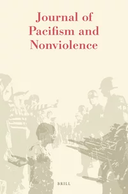Journal of pacifism and nonviolence
Abbreviation:
Journal of Pacifism and Nonviolence
Published by:
Brill
Journal Website:
https://brill.com/view/journals/jpn/jpn-overview.xml
Range of citations in the SafetyLit database:
2023; 1(1) --
2023; 1(1)
Publication Date Range:
2023 --
Number of articles from this journal included in the SafetyLit database:
9
(Download all articles from this journal in CSV format.)
pISSN = 2772-7874 | eISSN = 2772-7874
Find a library that holds this journal: http://worldcat.org/issn/27727874
Journal Language(s):
English
Aims and Scope (from publisher):
The Journal of Pacifism and Nonviolence aims to:
1. analyse and critique the considerable range of pacifist positions (political, ethical, religious, etc.) and approaches to nonviolence in both theory and practice, reflect on historical and more recent case studies (small- or large-scale), reflect on influential activists and social movements, and compare the effectiveness of violence and nonviolence as well as the effectiveness of the huge variety of tactics of nonviolent dissent;
2. interrogate central accusations against pacifism: that it reinforces the status quo; that it is predominantly white and middle class; that it cannot be sustained in the most challenging scenarios; that it is philosophically incoherent or morally impoverished, etc.;
3. discuss tensions between pacifism (as an ethical position) and nonviolence (as a form of political action) and consider criticisms of both;
4. consider, compare, and discuss theories and practices of pacifism and nonviolence (including those that have emerged in the Global South and/or that may employ vocabularies different from those employed in the Global North) and/or that may find expression through art/aesthetics;
5. study the multiple (political, social, economic, psychological, cultural, philosophical, etc.) direct and indirect consequences of violence and militarism and of nonviolent action and pacifism;
6. examine the place of violence and nonviolence in the history of political thought, in the arguments of core thinkers (e.g., Hobbes, Kant, Tolstoy, Gandhi, Schmidt, Arendt, Bourdieu, Butler), in those of overlooked or marginalised thinkers, as well as in political ideologies (e.g., anarchism, fascism, liberalism, feminism), in some of their principal concepts (e.g., masculinity, democracy, sovereignty, utopia, prefiguration, colonialism), and in relation to themes examined in cognate scholarship (e.g., technology, emotions, temporality, identity);
7. analyse the relationship between nonviolence/violence and gender, race, and other social identities; for example, how racism and patriarchy may be tied to the legitimation of violence and how racial and gender identities, norms, and/or privilege intersect with the practice and strategy of nonviolent action;
8. explore and debate the diverse religious/spiritual roots of pacifism and nonviolence past and present: Christian, Buddhist, Muslim, Indigenous, etc.;
9. debate the role of violence in popular culture past and present, the often lukewarm reception of pacifist ideas by the broader public, and the interests these serve;
10. assess the potential for not only nonviolent resistance but also nonviolent policies of governance (such as in public order maintenance, policing, crime management, and counterterrorism), nonviolent practices of protection (such as unarmed civilian protection and zones of peace), and practical proposals to move away from institutions that rely on violence (such as “trans-armament”, demilitarisation, and nonviolent civilian-based defence);
11. re-examine predominant assumptions in international relations theory and practice about terrorism, the international order, “just war”, etc.;
12. develop more precise conceptualisations of violence and nonviolence, reflecting on the exact nature of violence (e.g., institutional violence, property damage, racism, gendered constructs) and on the point at which direct action becomes violent;
13. identify and debate methodological challenges in researching pacifism and nonviolence, articulate pacifist critiques to research ethics, and reflect on pedagogies of pacifism and nonviolence.
The Journal of Pacifism and Nonviolence is committed to methodological pluralism and welcomes research employing either theoretical or empirical methods. It is rooted in politics and international relations (including security studies, social movements studies, political theory, peace studies, terrorism studies, strategic studies, and resistance studies) and is open to contributions grounded, for example, in historiography, sociology, anthropology, psychology, economics, geography, philosophy, and religious studies.
